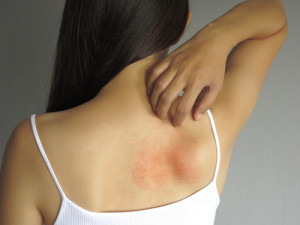Detergent Sensitivity
What is it, and how do I know if I have it?
 Detergent sensitivity is much more widespread than people generally realize. Up to 12% of the population may in fact be detergent sensitive to one degree or another. Potential misdiagnosis include eczema, psoriasis, and chronic dry skin which is made worse by exposure to detergent chemicals.
Detergent sensitivity is much more widespread than people generally realize. Up to 12% of the population may in fact be detergent sensitive to one degree or another. Potential misdiagnosis include eczema, psoriasis, and chronic dry skin which is made worse by exposure to detergent chemicals.
Detergent sensitivity differs from detergent allergies, which are believed to affect less than 1% of the population. An allergy is a protein antibody your body creates in response to a protein molecule entering the bloodstream and being marked as an invasive substance.
Detergents are not proteins however, and it is likely that allergic reactions to laundry detergent are in fact reactions to enzymes (proteins) used to break down stains rather than to the detergent chemical itself.
Chemical Sensitivities follow a different pathway in your body than allergies and the precise mechanism continues to be debated. It is this author’s hypothesis that infections of candida albicans and other endotoxins hyper sensitize the body’s inflammatory mechanism that normally exists to warn us to avoid overexposure to trigger molecules.
This hypersensitivity makes some of us intolerant to many of the aromatic molecules we are exposed to in daily life, especially to the ones that are not naturally occurring in the world that begat us.
An impaired liver combined with environmental endotoxins and overexposure to artificial molecules are a potential recipe for hypersensitivity in predisposed individuals.
In fact, 88.6% of people with multiple chemical sensitivities react to cleaning products – more than any other category! Detergents are a key component of nearly all cleaning products.
It is easy to test to see if you are detergent sensitive. Simply do not let anything that is not made by Vermont Soap touch your skin for 24 hours. If you do not see and feel an immediate improvement, look for other causes for your discomfort.
Start with your bedding – top and bottom sheets and pillowcases. Use a top sheet to separate you from your blankets, which will contain detergent residues. NEVER use fabric softener or dryer sheets – EVER!
Wash one complete set of clothing in Liquid Sunshine or Castile Liquid Soap.
Now clean yourself, using the Butter Bar or Unscented bar soaps. No shampoos, conditioners, moisturizers (you can use natural shea butter), lotions or deodorants etc. are to be used.
If we don’t make it – don’t put it on your skin.
If there is no change after 24 hours, look for food allergies as a primary trigger instead.
Larry Plesent is founder and CEO of Vermont Soap. He started the company after experiencing contact dermatitis for over 8 years as a result of overexposure to detergents as a window washer. He is happy to report that he has been symptom free since 1994 when he gave up all detergent products and switched to natural liquid soap products instead.